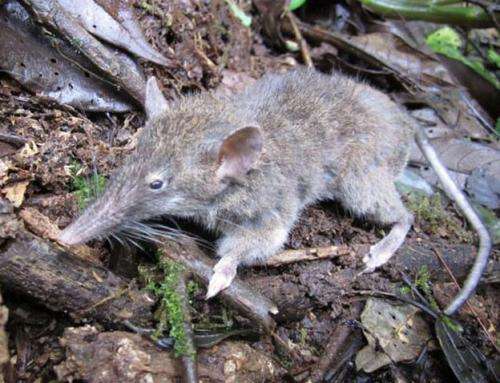Jake Esselstyn, a post-doctoral fellow in biology, has discovered a toothless rat on the island of Sulawesi in Indonesia. The rat's diet consists mainly of earth worms, meaning it does not need teeth to gnaw or chew.
(Phys.org)—A McMaster researcher has discovered a nearly toothless shrew rat on the Indonesian island of Sulawesi.
Jacob Esselstyn, a post-doctoral fellow in biology, and a team of researchers say the rodent – known as Paucidentomys vermidax – appears to eat soft, easy-to-chew earthworms.
Because of its unique diet, the rat is lacking all of its molars, leaving it only with incisors.
All of the planet's other 2,200 known species of rat have most, if not all, of their teeth.
"Growing teeth is energetically expensive," says Esselstyn. "If a characteristic is not useful, natural selection should eventually eliminate it, or at least reduce it to a vestigial state (in which it has lost its ancestral function)."
He says it probably took this rat hundreds of thousands of years to lose its teeth.
"This species illustrates how the process of evolution can lead to the reversal of previously successful traits when faced with new opportunities," the researchers wrote in the journal Biology Letters.
The team's work helps in the understanding of speciation – the evolutionary process by which new biological species arise.
"We live in a natural world," says Esselstyn. "We're a small part of that world and we're curious. We can't understand how ecosystems work if we don't even know how many species there are. It's in our own self-interest to better understand the world we live in."
The rats were found in the mountainous rain forests of Mount Latimojong and Mount Gandangdewata, on the southern part of the island. It's not the first time McMaster researchers have discovered previously unknown species on the island of Sulawesi.
Scientists led by biologist Ben Evans documented the rapid adaptation of a new fanged frog species on the island in research published in 2011. The team found 13 varieties of the frog, which has bony, tooth-like protrusions in their mouths.
Sulawesi is the world's eleventh-largest island, situated just west of the Indian Ocean. Its unique geology makes it a hotspot for scientists.
While Sulawesi is one island now, a few million years ago it was an archipelago. When those islands eventually collided, they formed a single, large island with a very complex shape.
The island, with its many peninsulas and large mountains, yields a great deal of potential for scientific research.
"We'd generally expect a large, isolated island with large mountains and a complex shape to produce a significant number of species," says Esselstyn. "There are certainly a lot of species on Sulawesi, but we only know of a very small subset of them."
More information: Jacob A. Esselstyn, Anang Setiawan Achmadi, and Kevin C. Rowe. Evolutionary novelty in a rat with no molars. Biol. Lett. rsbl20120574; published ahead of print August 22, 2012, doi:10.1098/rsbl.2012.0574 1744-957X
Journal information: Biology Letters
Provided by McMaster University




.jpg)


















